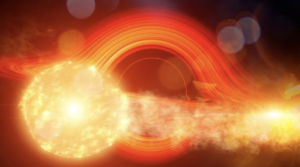NASA’s Swift Finds a Snacking Black Hole
NASA’s Neil Gehrels Swift Observatory scientists observed a black hole in a distant galaxy repeatedly munching on a Sun-like star. Swift science uses a unique way to analyze data from the satellite’s X-ray Telescope (XRT) and adapt to new areas of astrophysics.
A recent study published in Nature Astronomy tells the tale of an unlucky star and its hungry black hole. The star veered too close to the black hole, and gravitational force created intense tides that broke the star apart into a gas stream. The leading-edge swings around the black hole while the trailing edge escapes—this is called a tidal disruption event. They appear as flares of multiwavelength light created when debris collides with material orbiting the black hole.
When an orbiting star passes close to a black hole, the celebrity bulges outward and sheds material, but it survives. But when the process repeats, the star eventually loses too much gas and breaks apart.
June 22, 2022, was the first time the XRT captured Swift J0230. It lit up in a galaxy approximately 500 million light-years away in the northern constellation Triangulum.
Nine additional outbursts were seized from the exact location every few weeks. The Swift J0230 is a repeating tidal disruption of a Sun-like star orbiting a black hole with more than 200,000x the Sun’s mass. Each pass caused the star to lose approximately three Earth masses of material.
The discovery was possible thanks to a new, automated search of XRT observations called the Swift X-ray Transient Detector. Although Swift was created to study gamma-ray bursts, scientists have recognized its ability to study tidal disruptions and comets.


